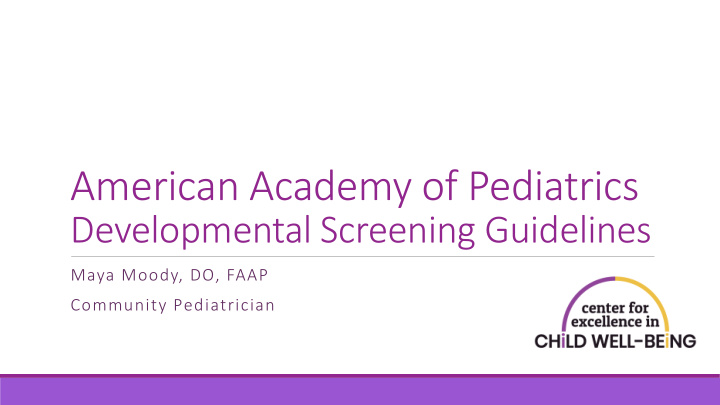



American Academy of Pediatrics Developmental Screening Guidelines Maya Moody, DO, FAAP Community Pediatrician
Why is development important? • Developmental disabilities are COMMON, 1 in 6 children ages 3-17 have a developmental disability. (CDC, Learn the Signs. Act Early.) • However, detection rates are much lower, and many are not identified until after entering school. • Early identification = Early intervention = Better outcomes and less cost
AAP Guidelines • Developmental surveillance at each well child visit • Structured developmental screening at 9, 18, and 24/30 month well child visits • Autism specific screen at 18 and 24 months • Social and emotional screening “at regular intervals” • Screening for adolescent depression • Kindergarten readiness screening
Definitions Surveillance (Monitoring) : the process of recognizing children who may be at risk of developmental delays ◦ Asking a few pointed questions regarding the child’s development Screening : the use of standardized tools to identify and refine that recognized risk ◦ Ages and Stages Questionnaire, PEDS or MCHAT Evaluation : a complex process aimed at identifying specific developmental disorders that are affecting a child ◦ Developmental pediatrician, often with physical, occupational and/or speech therapy
Surveillance or Monitoring “Flexible, longitudinal, continuous and cumulative process” – looking at the child over time using snapshots in time Provide an opportunity for: ◦ Referrals ◦ Providing education to support healthy development ◦ Monitoring the effects of developmental health promotion through early intervention and therapy
5 Components of Developmental Monitoring 1. Eliciting and Attending to the Parents’ Concerns 2. Maintaining a Developmental History 3. Making Accurate and Informed Observations of the Child 4. Identifying the Presence of Risk and Protective Factors 5. Documenting the Process and Findings
Eliciting and Attending to the Parents’ Concerns • “Do you have any concerns about your child’s development? Behavior? Learning?” • Important to use other descriptors when using the word “development” – many different understandings or meanings • Also important to ask about behavior, as developmental delays can present as behavior issues. • For example: Head banging in speech delay
Maintaining a Developmental History “What changes have you seen in your child’s development since our last visit?” Use of age-specific checklists
Making Accurate and Informed Observations of the Child Pediatricians: Careful physical and developmental examination Observation of parent-child interactions ◦ 9 month old sitting independently ◦ 15 month old walking around room ◦ 2 year old making eye contact, pointing at objects ◦ 3 year old speaking clearly in short sentences
Identifying the Presence of Risk and Protective Factors Protective Factors Risks ◦ Strong connections within a ◦ Environmental loving, supportive family ◦ Genetic ◦ Opportunities to interact with ◦ Biological other children and grow ◦ Social independence in an environment with appropriate ◦ Demographic structure
Documenting the Process and Findings Specific actions taken or planned Referrals to: ◦ Medical providers ◦ Early childhood programs/intervention
Developmental Surveillance and Screening in the Pediatric Medical Home Developmental surveillance and physical exam at each well child visit ◦ Elicit parent concerns ◦ Age-specific checklist in medical record ◦ Observations of the child ◦ Documenting concerns, referrals, interventions Perform a structured developmental screen at 9, 18 and 24/30 month well child visits
9 months • Identification of issues of motor skills development • Monitoring for early communication skills • Social and nonverbal communication • Encourage parents to pay attention to communication and language skills
18 months • Identification of delays in communication and language development • Motor delays not identified at 9 month screening may be more evident • Autism specific screening tool also recommended at 18 month well child visit
24 or 30 months By 2 years of age, most delays can be detected with structured developmental screening. Early intervention is key to the child’s future success
Developmental screening tools • Brief standardized, validated tool for specific age ranges • Many are completed by parents, scored by clinic personnel and interpreted by the physician • Developmental screening does not establish a diagnosis or treatment plan • Identifies areas of concern that need further evaluation and intervention
Developmental “growth curves” The use of developmental surveillance/monitoring checklists and developmental screening tools are the “growth curves” for development. Child health professionals should not solely use clinical judgement when assessing a child’s development
Developmental and Medical Evaluation • When developmental screening identifies a child with developmental concerns, then a diagnostic evaluation should be completed. • Comprehensive medical diagnostic evaluation to identify possible causes of developmental delay • Often interdisciplinary team of pediatric specialists and early childhood professionals • Developmental pediatrician, child neurologist • Speech-language pathologists, occupational therapists, physical therapists, audiologists
Early Developmental Intervention Early Childhood Services • Programs can provide initial developmental evaluations and offer services even before entire evaluation completed. • Developmental therapies, service coordination, social work services, family training and home visitation. • Diagnosis of a specific developmental disorder is not necessary for an early intervention referral to be made. • Early identification = early intervention = better outcomes!
It takes a village…
American Academy of Pediatrics articles Identifying Infants and Young Children With Developmental Disorders in the Medical Home: An Algorithm for Developmental Surveillance and Screening. Pediatrics 2006;118;405 Identification and Evaluation of Children With Autism Spectrum Disorders. Chris Plauché Johnson and Scott M. Myers, Pediatrics 2007;120;1183 Promoting Optimal Development: Screening for Behavioral and Emotional Problems. Carol Weitzman, Lynn Wegner, Pediatrics 2015;135;384
Maya Moody DO, FAAP moodyme@health.missouri.edu
Recommend
More recommend